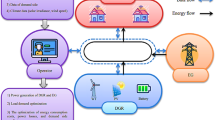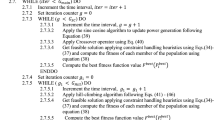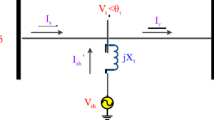Abstract
One of the main objectives of power system restructuring is to realize the choice of customers on their desired reliability levels in Spinning Reserve (SR) market. The reliability preferences of customers can affect required SR capacity significantly. So it is necessary to improve the operation of power system by developing the techniques based on customer choice on reliability. In this paper, a novel index is proposed for declaring the reliability preferences, named as Load Value Function (LVF) which is an exponential function of customer’s demand. A developed joint energy and SR markets clearing model is presented in which the declared LVFs are applied in SR capacity scheduling. The proposed market model is a stochastic nonlinear programming problem that minimizes the pre-contingency operation cost, the post-contingency expected operating cost associated with the SR scheduling and the total Expected Load Not Supplied (ELNS) cost of power system based on the proposed index. The modified IEEE reliability test system (IEEE-RTS) is used to evaluate the effectiveness of the proposed index in SR requirement determination problem. Also a comparison is performed between two cases in which the desired reliability levels of customers are based on the fixed Value of Lost Load (VOLL) and the proposed index.

Similar content being viewed by others
Abbreviations
- N g :
-
Set of all generators
- N b :
-
Set of all buses
- N l :
-
Set of all branches
- S :
-
Set of all contingencies
- N d :
-
Set of all loads
- \({P_{g,i}^{\min}}\) :
-
Lower limit on generator capacity in pre-and post-contingency states
- \({P_{g,i}^{\max}}\) :
-
Upper limit on generator capacity in pre- and post-contingency states
- \({P_{ij}^{\max}}\) :
-
Line power flow capacity of line i–j in pre-and post-contingency states
- Rmpu g,i :
-
Maximum sustained ramp-up rate (MW/min) of a unit.
- Rmpd g,i :
-
Maximum sustained ramp-down rate (MW/min) of a unit.
- VOLL i :
-
Value of lost load of customer i
- CP i :
-
Reliability preferences coefficient of customer i
- P d,i :
-
Power demand of customer i in energy market
- ρ g,i :
-
Offered price by generator i for production in the pre-contingency state
- ρ ru,i :
-
Offered rate by generator i to provide up-spinning reserve.
- ρ rd,i :
-
Offered rate by generator i to provide down-spinning reserve.
- B :
-
DC load flow matrix in the pre-contingency state.
- B i :
-
ith row of matrix B corresponding to bus i
- B ij :
-
Corresponding element to ith row and jthcolumn of matrix B
- B s :
-
DC load flow matrix under contingency s.
- \({B_i^s}\) :
-
ith row of matrix B scorresponding to bus i
- \({B_{ij}^s}\) :
-
Corresponding element to ith row and jth column of matrix B
- prob s :
-
Occurrence probability of state s
- n sys :
-
Total number of components in the system
- n f :
-
Number of unavailable system components in state s
- U c :
-
Unavailability probability of component c
- P g,i :
-
Generator i power output in pre-contingency state Binary (0/1) variable denoting the off/on status
- u g,i :
-
of the generator i
- P ru,i :
-
Up-spinning reserve provided by generator i
- P rd,i :
-
Down-spinning reserve provided by generator i
- δ :
-
Vector of nodal phase angles for the pre-contingency state
- \({\delta _i, \delta _j}\) :
-
Nodal phase angles of buses i and j for the pre-contingency state
- δ s :
-
Vector of nodal phase angles under contingency s
- \({\delta _i^s, \delta _j^s}\) :
-
Nodal phase angles of buses i and j under contingency s
- \({P_{g,i}^s}\) :
-
Generator i power output under contingency s
- LNS s,i :
-
Load Not Supplied of customer i under contingency s
- A i :
-
Subscripted SR capacity of customer i
- LVF i (A i ):
-
Load value function of customer i
References
Billinton, R.; Allan, R.N.: Reliability Evaluation of Power Systems, 2nd edn. Plenum Press, USA (1996)
Wood, A.J.; Wollenberg, B.F.: Power Generation, Operation and Control. Wiley, New York (1996)
Wu, T.; Rothleder, M.; Alaywa, Z.; Papalexopoulos, A.D.: Pricing energy and ancillary services in integrated market systems by an optimal power flow. IEEE. Trans. Power. Syst. 19, 339–347 (2004)
Li, Z.; Shahidehpour, M.: Security constrained unit commitment for simultaneous clearing of energy and ancillary services markets. IEEE. Trans. Power. Syst. 20, 1079–1088 (2005)
Haghighat, H.; Seifi, H.; Kian, A.R.: Gaming analysis in joint energy and spinning reserve markets. IEEE. Trans. Power. Syst. 22, 2074–2085 (2007)
Wen, F.; David, A.K.: Coordination of bidding strategies in day-ahead energy and spinning reserve markets. Int. J. Electr. Power. Energy. Syst. 24, 251–261 (2002)
Soleymani, S.; Ranjbar, A.M.; Shirani, A.R.: New approach for strategic bidding of gencos in energy and spinning reserve markets. Energy. convers. Manag. 48, 2044–2052 (2007)
Hejazi. H.A.; Mohabati, H.R.; Hosseinian, S.H.; Abedi, M.: Differential evolution algorithm for security-constrained energy and reserve optimization considering credible contingencies. IEEE. Trans. Power. Syst. 26, 1145–1155 (2011)
Singh, H.; Papalexopoulos, A.: Competitive procurement of ancillary services by an independent system operator. IEEE Trans. Power Syst. 14, 498–504 (1999)
Nasr Azadani, E.; Hosseinian, S.H.; Moradzadeh, B.: Generation and reserve dispatch in a competitive market using constrained particle swarm optimization. Int. J. Electr. Power. Energy. Syst. 32, 79–86 (2010)
Ehsani, A.; Ranjbar, A.M.; Fotuhi-Firuzabad, M.: Optimal and reliable scheduling of competitive electricity markets—a probabilistic approach. Arab. J. Sci. Eng. 32, 281–300 (2007)
Madrigal, M.; Quintana, V.H.: A security-constrained energy and spinning reserve markets clearing system using an interior-point method. IEEE. Trans. Power. Syst. 15, 1410–1416 (2000)
Wang, J.; Redondo, N.E.; Galiana, F.D.: Demand-side reserve offers in joint energy/reserve electricity markets. IEEE. Trans. Power. Syst. 18, 1300–1306 (2003)
Rau, N.S.: Optimal dispatch of a system based on offers and bids—a mixed integer LP formulation. IEEE Trans. Power Syst. 14, 274–279 (1999)
Wang, J.; Shahidehpour, M.; Li, Z.: Contingency-constrained reserve requirements in joint energy and ancillary services auction. IEEE. Trans. Power. Syst. 24, 1457–1468 (2009)
Wong, S.; Fuller, J.D.: Pricing energy and reserves using stochastic optimization in an alternative electricity market. IEEE. Trans. Power. Syst. 22, 631–638 (2007)
Arroyo, J.M.; Galiana, F.D.: Energy and reserve pricing in security and network-constrained electricity markets. IEEE. Trans. Power. Syst. 20, 634–643 (2005)
Shayesteh, E.; Yousefi, A.; Parsa Moghaddam, M.: A probabilistic risk-based approach for spinning reserve provision using day-ahead demand response program. Energy 35, 1908–1915 (2010)
Afshar, K.; Ehsan, M.; Fotuhi-Firuzabad, M.; Amjady, N.: Cost-benefit analysis and MILP for optimal reserve capacity determination in power system. Appl. Math. Comput. 196, 752–761 (2008)
Chattopadhay, D.; Baldick, R.: Unit commitment with probabilistic reserve. IEEE. Power. Eng. Soc. Winter. Meet. 1, 280–285 (2002)
Doherty, R.; O’Malley, M.: A new approach to quantify reserve demand in systems with significant installed wind capacity. IEEE. Trans. Power. Syst. 20, 587–595 (2005)
Bai, J.; Gooi, H.B.; Xia, L.M.; Strbac, G.; Venkatesh, B.: A probabilistic reserve market incorporating interruptible load. IEEE. Trans. Power. Syst. 21, 1079–1087 (2006)
Jaefari-Nokandi, M.; Monsef, H.: Scheduling of spinning reserve considering customer choice on reliability. IEEE. Trans. Power. Syst. 24, 1780–1789 (2009)
Bouffard, F.; Galiana, F.D.; Conejo, A.J.: Market-clearing with stochastic security—part I: formulation. IEEE. Trans. Power. Syst. 20: 1818–1826 (2005)
Bouffard, F.; Galiana, F.D.; Conejo, A.J.: Market-clearing with stochastic security—part II: case studies. IEEE. Trans. Power. Syst. 20, 1827–1835 (2005)
Ahmadi-Khatir, A.; Cherkaoui, R.: A probabilistic spinning reserve market model considering DisCo’s different value of lost loads. Electr. Power. Syst. Res. 81, 862–872 (2011)
Amjady, N.; Aghaei, J.; Shayanfar, H.A.: Stochastic multiobjective market clearing of joint energy and reserves auctions ensuring power system security. IEEE Trans. Power Syst. 24, 1841–1854 (2009)
Aghaei, J.; Shayanfar, H.A.; Amjady, N.: Multi-objective market-clearing of joint energy and reserves auctions ensuring power system security. Energy. Convers. Manag. 50, 1149–1156 (2009)
Aghaei, J.; Amjady, N.: A scenario-based multi-objective operation of electricity markets enhancing transient stability. Int. J. Electr. Power. Energy. Syst. 35, 112–122 (2012)
Najafi, M.; Ehsan, M.; Fotuhi-Firuzabad, M.; Akhavein, A.; Afshar, K.: Optimal reserve capacity allocation with consideration of customer reliability requirements. Energy 35, 3883–3890 (2010)
Ahmadi-Khatir, A.; Fotuhi-Firuzabad, M.; Goel, L.: Customer choice of reliability in spinning reserve procurement and cost allocation using well-being analysis. Electr. Power. Syst. Res. 79, 1431–1440 (2009)
Wacker, G.; Billinton, R.: Customer cost of electric service interruptions. Proc. IEEE. 77, 919–930 (1989)
Billinton, R.; Tollefson, G.; Wacker, G.: Assessment of electric service reliability worth. Int. J. Electr. Power. Energy. Syst. 15, 95–100 (1993)
Nooij, M.; Koopmans, C.; Bijvoet, C.: The value of supply security. The costs of power interruptions: economic input for damage reduction and investment in networks. Energy. Econ. 29, 205–277 (2007)
Grigg, C.; Wong, P.; Albrecht, P.; Allan, R.; Bhavaraju, M.; Billinton, R.; Chen, Q.; Fong, C.; Haddad, S.; Kuruganty, S.; Li, W.; Mukerji, R.; Patton, D.; Rau, N.; Reppen, D.; Schneider, A.; Shahidehpour, M.; Singh, C.: A report prepared by the reliability test system task force of the application of probability methods subcommittee. The IEEE reliability test system-1996. IEEE. Trans. Power. Syst. 14, 1010–1020 (1999)
Author information
Authors and Affiliations
Corresponding author
Rights and permissions
About this article
Cite this article
Amirahmadi, M., Akbari Foroud, A. Optimal Spinning Reserve Requirement Determination Considering Reliability Preferences of Customers. Arab J Sci Eng 39, 4945–4962 (2014). https://doi.org/10.1007/s13369-014-1160-1
Received:
Accepted:
Published:
Issue Date:
DOI: https://doi.org/10.1007/s13369-014-1160-1




